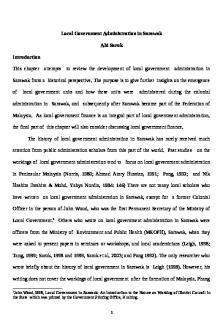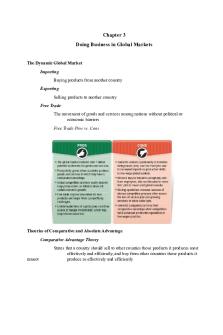Government Actions in Markets PDF

| Title | Government Actions in Markets |
|---|---|
| Author | Victoria Frank |
| Course | Introduction To Economics |
| Institution | Virginia Commonwealth University |
| Pages | 5 |
| File Size | 78 KB |
| File Type | |
| Total Downloads | 77 |
| Total Views | 175 |
Summary
Professor Michael Gilbert...
Description
Chapter 7: Government Actions in Markets Tax Incidence: - The division of the tax between the buyer and seller - When a good is taxed, it has two prices: - A price that includes the tax - A price that excludes the tax - Buyers respond to the price that includes the tax - Sellers respond to the price that excludes the tax - Tax is like a “wedge” between two prices Taxes and Efficiency: - A tax places a wedge between the buyers’ price (marginal benefit) and the seller's’ price (marginal cost) - The equilibrium quantity is less than the efficient quantity and a deadweight loss arises - Tax inefficiency: - Total surplus (the sum of consumer surplus and producer surplus) is maximized - Marginal benefit exceeds marginal cost - Consumer surplus and producer surplus shrink - The government collects its tax revenue - A deadweight loss arises Tax Burden: - The loss of consumer surplus and producer surplus is the burden of the tax - Burden of Tax: tax revenue + deadweight loss - Excess Burden: the deadweight loss from a tax - Excess burden is the amount by which the burden of tax exceeds the tax revenue received by the government Incidence, Inefficiency, and Elasticity: - The incidence of a tax and its excess burden depend on the elasticities of demand and supply - For a given elasticity of supply, the buyer pays a larger share of the tax, the more inelastic is the demand for the good - For a given elasticity of demand, the seller pays a larger share of the tax, the more inelastic is the supply of the good - Excess burden is smaller, the more inelastic is demand or supply Incidence, Inefficiency, and Elasticity of Demand: - Perfectly Inelastic Demand: buyer pays tax and efficient - Perfectly Elastic Demand: seller pays tax and inefficient Incidence, Inefficiency, and Elasticity of Supply:
-
Perfectly Inelastic Supply: seller pays tax and efficient Perfectly Elastic Supply: buyer pays tax and inefficient
Price Ceilings: - Price Ceiling/Cap: government regulation that places an upper limit on the price at which a particular good, service, or factor of production may be traded - Ex: price ceiling on housing rents - Trading above the price ceiling is illegal A Rent Ceiling: - Regulation that makes it illegal to charge more than a specified rent for housing - Effect of a rent ceiling depends on whether it is imposed at a level above or below the market equilibrium net - When a rent ceiling creates a housing shortage, two developments occur: - A black market - Increased search activity - Black Market: illegal market that operates alongside a government-regulated market - Search Activity: time spent looking for someone with whom to do business - If they’re so bad, why do we have them? - Current renters gain and lobby politicians - There are more renters than landlords, so rent ceilings can tip an election Are Rent Ceilings Efficient? - With a rent ceiling, the outcome is inefficient - Marginal benefit exceeds marginal cost - Total surplus (sum of producer surplus and consumer surplus) shrinks and a deadweight loss arises - People who can’t find housing and landlords who can’t offer housing at a lower rent lose - Efficient housing market: - Market is efficient with marginal benefit = marginal cost - Consumer surplus = producer surplus is as large as possible - Inefficiency of rent ceiling: - Rent ceiling restricts the quantity supplied, so marginal benefit exceeds marginal cost - Consumer surplus shrinks - Producer surplus shrinks - Deadweight loss arises - Other resources are lost in search activity and evading and enforcing the rent ceiling law Price Floors: - Price Floor: a government regulation that places a lower limit on the price at which a particular good, service, or factor of production may be traded
-
- Ex: minimum wage in labor markets Trading below the price floor is illegal
The Minimum Wage: - Minimum Wage Law: government regulation that makes hiring labor for less than a specified wage illegal - Firms can pay a wage rate above the minimum wage but they may not pay a wage rate below the minimum wage - The effect of a minimum wage depends on whether it is set above or below the market equilibrium wage rate - High unemployment achieved by: - Increased search activity - Illegal hiring - If it’s so bad, why do we have minimum wage? - The effects of minimum wage on employment might be small - Labor unions might lobby for minimum wage Is the Minimum Wage Efficient? - The firms’ surplus and workers’ surplus shrink, and a deadweight loss arises - Firms that cut back employment and people who can’t find jobs at the higher wage rate lose - The total loss exceeds the deadweight loss because resources get used in costly job-search activity - Efficient labor market: - At the market equilibrium, the marginal benefit of labor to firms equals the marginal cost of working - The sum of the firms’ surplus and the worker's’ surplus is as large as possible - Inefficient labor market: - Minimum wage restricts the quantity demanded - The firms’ surplus shrinks - The workers’ surplus shrinks - Deadweight loss arises - Other resources are used up in job-search activity Production Quotas: - Production Quota: government regulation in a market that places an upper limit on the quantity that may be supplied - Governments often intervene in agriculture markets with the aims of blocking the quantity supplied from moving toward the equilibrium quantity - To regulate the quantity supplied, government must isolate the domestic market from global competition - For this reason, government restricts quantity that can be imported from other countries
-
To make production quota effective, quotas must be allocated to each producer that sum to the market quota - Individual producers must be prevented from exceeding their quotas
Example of Production Quota: - The market for dairy products in California is regulated by the California Department of Food and Agriculture - A production quota for the market is set and allocations are made to each producer that sum to the market quota - Free Market Reference Point: - With no production quota: - The market equilibrium is efficient - Consumer surplus + producer surplus is maximized - Effective production quota: - Consumer surplus shrinks - Producer surplus grows - Deadweight loss arises - Production quota is inefficient: - Inefficient because it creates deadweight loss - Farmers gain and buyers lose, but buyers lose more than farmers gain - Production quota is unfair: - Unfair on both views of fairness: - Result-View: with the quota, well-off farmers benefit and consumers lose - Rule-View: quota blocks voluntary exchange; farmers want to produce more and consumers want to buy more, but they are not permitted by the quota...
Similar Free PDFs

Government Actions in Markets
- 5 Pages

Local government in India
- 18 Pages

Electronic Government in Action
- 273 Pages

E-Government in Action
- 195 Pages

Amazon in Emerging Markets Case
- 41 Pages

1170.4 Earthquake actions
- 61 Pages

1170.2 Wind Actions -
- 101 Pages

10 Muscle Actions Key
- 8 Pages
Popular Institutions
- Tinajero National High School - Annex
- Politeknik Caltex Riau
- Yokohama City University
- SGT University
- University of Al-Qadisiyah
- Divine Word College of Vigan
- Techniek College Rotterdam
- Universidade de Santiago
- Universiti Teknologi MARA Cawangan Johor Kampus Pasir Gudang
- Poltekkes Kemenkes Yogyakarta
- Baguio City National High School
- Colegio san marcos
- preparatoria uno
- Centro de Bachillerato Tecnológico Industrial y de Servicios No. 107
- Dalian Maritime University
- Quang Trung Secondary School
- Colegio Tecnológico en Informática
- Corporación Regional de Educación Superior
- Grupo CEDVA
- Dar Al Uloom University
- Centro de Estudios Preuniversitarios de la Universidad Nacional de Ingeniería
- 上智大学
- Aakash International School, Nuna Majara
- San Felipe Neri Catholic School
- Kang Chiao International School - New Taipei City
- Misamis Occidental National High School
- Institución Educativa Escuela Normal Juan Ladrilleros
- Kolehiyo ng Pantukan
- Batanes State College
- Instituto Continental
- Sekolah Menengah Kejuruan Kesehatan Kaltara (Tarakan)
- Colegio de La Inmaculada Concepcion - Cebu







